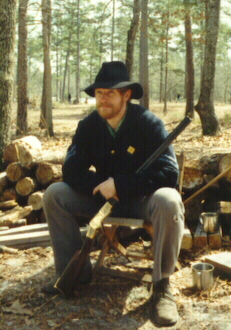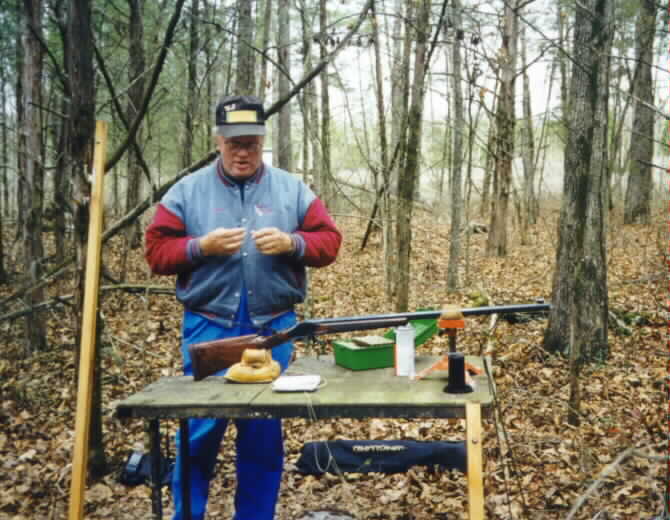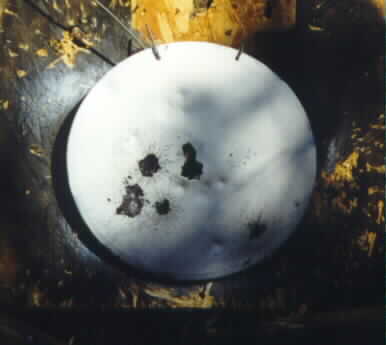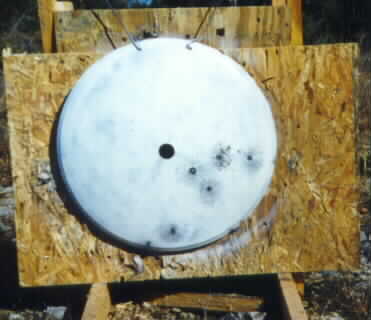
Buffalo Buck
Shoot Today, Kills Tomorrow Guns
Long
Range Shooting
By: Buffalo Buck
5042 LTG
2000

Buffalo Buck
There has been a lot written about different loads and what works best. There have been articles on different rifles for long range shooting and targets used. Here are a few helpful hints I have used in trying to hit those targets at long range with cartridges that shoot like a mortar instead of a modern flat shooting rifle.
The most important thing in hitting at long range is to find an accurate load. This can take months of experimenting to find what combination of powder, bullets, lube, wads, casings and primers that will work best in your rifle. If you are lucky you can find an accurate load very quickly. Do not start out by shooting off-hand or even from shooting sticks. Use a rock-steady bench with the rifle supported at both ends.

"Old Sarge
Sutter"
It is very important to mention that in the development stage of testing a given load that you use the bench to shoot from with as steady of a rest as possible. You want to see how tight a group the load will shoot. Shooting at 100 yards will give you an idea but it is better to shoot groups at 200 yards to give you a true indication of what the load is capable of at longer ranges. If all you have is a 100 yard range then you should be able to shoot under 2 inches with 5 shot groups. If your load will not shoot under 2 inches there is a good chance you will be way off the further out you go. At 200 yards you should be able to shoot a 4 inch group or even less in some cases. There is a lot of satisfaction in being able to put 10 shots in a 4 inch group at 200 yards. At 300 yards my groups open up to around 5 to 6 inches.
Keep a range book to take notes of everything you do. This should include information in detail of the load you are shooting, the firearm used, procedures, plotting impact of bullets on the target, date, time of day, weather conditions as well as what distance you were shooting and sight settings.

200 Yards at a 16 inch
gong
405 Bull X Bullet 65 gr. Pyrodex Select
Again all of your shooting should be done from the bench with a rock-steady rest. I usually keep two range books. One is for when I am testing loads that include all of the above mentioned details. When testing loads it works best if you have a friend to spot where the bullets are going. It is a simple matter of "walking" the bullets into the target and then record the correct sight setting. Without a spotter it is almost impossible to see where your bullets are hitting especially if you are shooting black powder. Fire at least 5 shots before making any sight corrections for the load. My second range book looks like the example below.
Firearm:
________________________
Caliber: _________________________
Powder: _________________________
Bullet: __________________________
Lube: ________________________
Primer: ______________________
Wads: _______________________
Casings: ____________________
Velocity: _____________________
Range: _______________________
Sight Settings: ________________
Notes:
This is the book I take to a match or the range when I want to practice. By using this book it is very simple to look up and see what to set your sights on at the different ranges with the loads that you have already experimented with. It takes the guess work out of where to set your sight. It is also a lot easier on the old brain in remembering "where did I have the sights the last time I hit the target". You can customize your own range book to include what information you want to put in it. This is what works for me. When I miss I know that it is usually me and not the gun.
Tang sights are also very important. You want a tang sight that will positively lock in place with absolutely no play either forward to back or side to side. There are many cheap sights out there but then that is what you get, a cheap sight. C Sharps, Montana Vintage and others make excellent sights. These can be expensive but you get what you pay for. I have a C Sharps Mid-Range adjustable for windage and elevation on my Shiloh .45-120 and a Montana Vintage Long Range adjustable for windage and elevation on my Shiloh .45-70. The sights need to be mounted on the rifle at the right angle to line up with the front sights level. The front sight should be one that has the ability to have interchangeable inserts. For long range shooting I like the thin post. A Spirit Level sight is nice but it is not needed.
When sighting from the bench try to have a "Neutral hold" or in other words, sight the gun then let lose of it and the sights should still be on target. Try to avoid using pressure from your hand to keep the gun on target. Something as small as your heart beat can throw you off target. At long range this is more critical than at the shorter distances. Keep in mind you are interested in what the load will do under the best possible conditions. That way you will know what a given load is capable of doing. By knowing this you will have a better chance of hitting off-hand or from shooting sticks.
Here are some of the .45-70 loads that I have used with success. As with any reloading information given, they worked in my guns and I do not recommend any load but include as a point of information. Disclaimer: I do not recommend any loads but encourage you to use one of the outstanding reloading manuals by the established companies that are offered for sale.
Load 1: IMR 3031 with
40 grains
405 Bull X lead bullet
Winchester Western Rifle Mag. Primer
Starline Casings
Load 2: Pyrodex Select with 65 grains
405 Bull X lead bullet
215 Federal Primer
Winchester Casings
No wads
Load 3: Pyrodex Select with 65 grains
500 cast Lyman RN Bullet
SPG Lube
215 Federal Primer
Winchester Casings
No Wads
Load 4: Goex FFg 65 grains
500 cast RN Lyman
SPG Lube
215 Federal Primer
No Wads
Winchester Casings
When shooting black powder or Pyrodex it is important to compress the load slightly, usually around a 1/16 of an inch.
All of these loads shoot very well in my .45-70 Shiloh Sharps Hartford Model. I have used Wonder Wads and grease wads in the past but they did not seem to offer any improvement over loads not using them. In fact the use of wads seemed to open my groups slightly. Leading has not been a serious problem. Other rifles might like different loads and may like the use of wads. Each gun is different. My Sharps likes the 500 grain bullets while a friends Browning High Wall does not. When shooting black powder or Pyrodex I do use a blow tube between shots. This helps keep the fouling soft and does help with accuracy.
Clean up of black powder rifle and brass is very important and can be generally done with soapy water. I have a water jug filled with soapy water that the brass goes into after I take them out of the gun. I do a preliminary cleaning of the barrel while at the range with soapy water and finish up at home with a good powder solvent from "ProShot" for lead bullets to remove any lead. Usually there is very little lead in the barrel using the Bull X 405 bullets.

300 Yards .45-70
22 inch gong
65 grains of Pyrodex Select
405 Bull X
215 Federal Primer
WW Casings
No Wads
5 shots from cross sticks
4 shot group of a little under 6 inches
In summary the two important hints to remember are:
1. Use a rock-steady rest with the rifle supported at both ends in the development stage of your loads and sight settings. You can’t know where to set your sight unless you are consistent in your shooting. For this you need a good rest.
2. Keep a range book. Record everything that you do. This way you will know what will work and what will not. It takes the guess work out of hitting. If you miss then it is probably you and not the gun.
I wish I could say that I found all of this information out myself and I knew everything about long range shooting but unfortunately I do not. It is fun to experiment and find what different loads will work at different distances. The OLE "Bench Master", Dave Sutter got me to hit targets that I only dreamed about hitting. He is probably one the best long range shooters I have seen and he has helped me out greatly with much of the information seen here. There is satisfaction hitting targets out almost further than you can see.
Good luck and good shooting. Make those old Buffalo Guns bark.
"Buffalo Buck"
Andrew L. Bresnan